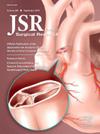Anterior Transversus Abdominis Plane Block for Lower Extremity Revascularization
IF 1.8
3区 医学
Q2 SURGERY
引用次数: 0
Abstract
Introduction
Regional anesthesia remains underutilized in vascular surgery; therefore, we retrospectively reviewed and compared the usage of perioperative opioids in patients undergoing lower extremity revascularization surgery, who received the anterior transversus abdominis plane (TAP) block along with local anesthesia at the incision site versus who did not receive any regional anesthesia.
Methods
We conducted a retrospective review of 107 patients undergoing open or hybrid lower extremity revascularization under general anesthesia at a single institution between 2017 and 2022. Patients were divided into two groups. Regional block group (n = 41 [38%]) (femoral endarterectomy 27%; femoral endarterectomy + endovascular intervention 51%; infrainguinal bypass 22%) received both an intraoperative anterior TAP block and local anesthesia at the incision site; No regional block group (n = 66 [62%]) (femoral endarterectomy 29%; femoral endarterectomy + endovascular intervention 13%; infrainguinal bypass 58%) did not receive either regional or local anesthesia.
Results
There were no significant differences in either the procedural metrics or intraprocedural complications between the two groups. The in-hospital stay was shorter in the Regional group, 1 (1, 3) versus the No regional group, 3 (2, 7), P < 0.001. The median intraoperative morphine milliequivalents use was 20 (15, 25) in the Regional block group and 25 (20, 35) in the No regional block group, P = 0.008. The median postoperative opioids use at 24h was 75 (60, 98) in the Regional block group and 113 (83, 151) in the No regional block group, P < 0.001; at 48h was 103 (70, 118) in the Regional block group and 148 (90, 210) in the No regional block group, P = 0.027; at 72h was 105 (70, 138) in the Regional block group and 196 (113, 263) in the No regional block group, P = 0.010.
Conclusions
Anterior TAP block combined with local anesthesia at the incision site seems to be a safe postoperative analgesia option for patients undergoing lower extremity revascularization surgery that could potentially help reducing both intra and postoperative opioids requirement.
前腹横面阻滞治疗下肢血运重建术。
导论:区域麻醉在血管手术中的应用仍不充分;因此,我们回顾性地回顾并比较了在接受下肢血运重建术的患者围手术期阿片类药物的使用情况,在切口处接受前腹横平面(TAP)阻滞并局部麻醉与未接受任何区域麻醉的患者。方法:我们对2017年至2022年在单一机构接受全麻下开放或混合下肢血运重建术的107例患者进行了回顾性分析。患者分为两组。局部阻滞组(n = 41[38%])(股动脉内膜切除术27%;股动脉内膜切除术+血管内介入治疗51%;腹股沟下旁路22%)术中同时接受前路TAP阻滞和切口局部麻醉;无区域阻滞组(n = 66[62%])(股动脉内膜切除术29%;股动脉内膜切除术+血管内介入治疗13%;腹股沟下旁路(58%)未接受区域或局部麻醉。结果:两组在手术指标和术中并发症方面均无显著差异。区域组的住院时间比非区域组短1 (1,3),3 (2,7),P结论:对于接受下肢血运重建术的患者,前路TAP阻滞联合切口局部麻醉似乎是一种安全的术后镇痛选择,可能有助于减少术中和术后阿片类药物的需求。
本文章由计算机程序翻译,如有差异,请以英文原文为准。
求助全文
约1分钟内获得全文
求助全文
来源期刊
CiteScore
3.90
自引率
4.50%
发文量
627
审稿时长
138 days
期刊介绍:
The Journal of Surgical Research: Clinical and Laboratory Investigation publishes original articles concerned with clinical and laboratory investigations relevant to surgical practice and teaching. The journal emphasizes reports of clinical investigations or fundamental research bearing directly on surgical management that will be of general interest to a broad range of surgeons and surgical researchers. The articles presented need not have been the products of surgeons or of surgical laboratories.
The Journal of Surgical Research also features review articles and special articles relating to educational, research, or social issues of interest to the academic surgical community.

 求助内容:
求助内容: 应助结果提醒方式:
应助结果提醒方式:


